MMP311 Trimester 2: Literature Review on Heritage Property Valuation
VerifiedAdded on 2022/10/07
|20
|4139
|17
Literature Review
AI Summary
This literature review examines the valuation of heritage properties, particularly in Australia, exploring the unique challenges and methodologies involved. The study begins with an executive summary and table of contents, followed by an introduction that defines specialized and heritage buildings, emphasizing their architectural, artistic, and cultural significance. It then details the heritage sites of Australia, categorized by UNESCO, and lists properties maintained by the Australian Department of the Environment and Energy. The review highlights the advantages of heritage listings, including preservation, tourism, research, and community benefits. It discusses property valuation, legal constraints, and the responsibilities of valuers, outlining various valuation methods such as comparison, profits, residual, contractor, and investment approaches. The review also delves into valuation research, findings, and considerations for evaluating heritage properties, concluding with limitations and a summary of the key insights. The paper provides a comprehensive overview of heritage property valuation, including legal aspects, valuation methods, and market analysis.
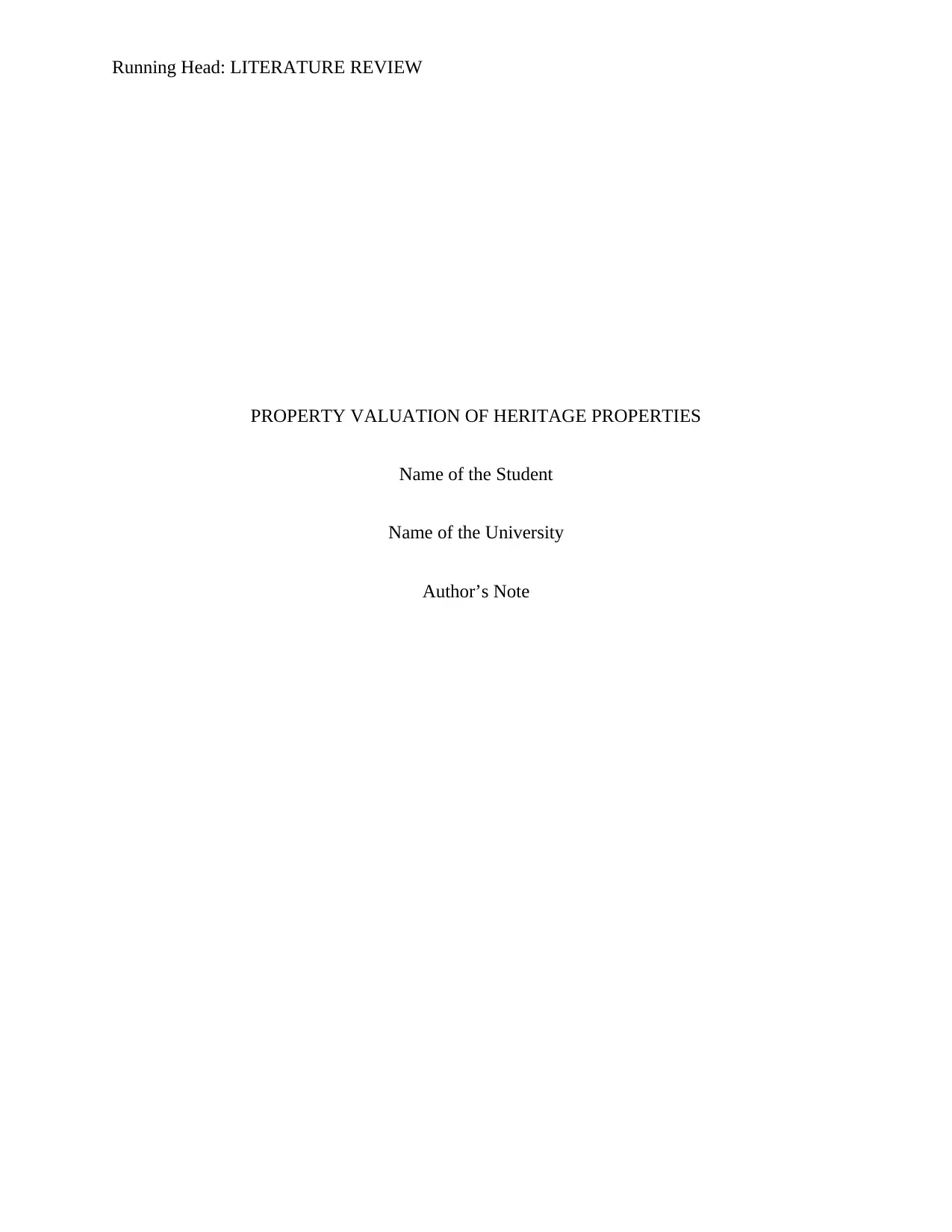
Running Head: LITERATURE REVIEW
PROPERTY VALUATION OF HERITAGE PROPERTIES
Name of the Student
Name of the University
Author’s Note
PROPERTY VALUATION OF HERITAGE PROPERTIES
Name of the Student
Name of the University
Author’s Note
Paraphrase This Document
Need a fresh take? Get an instant paraphrase of this document with our AI Paraphraser
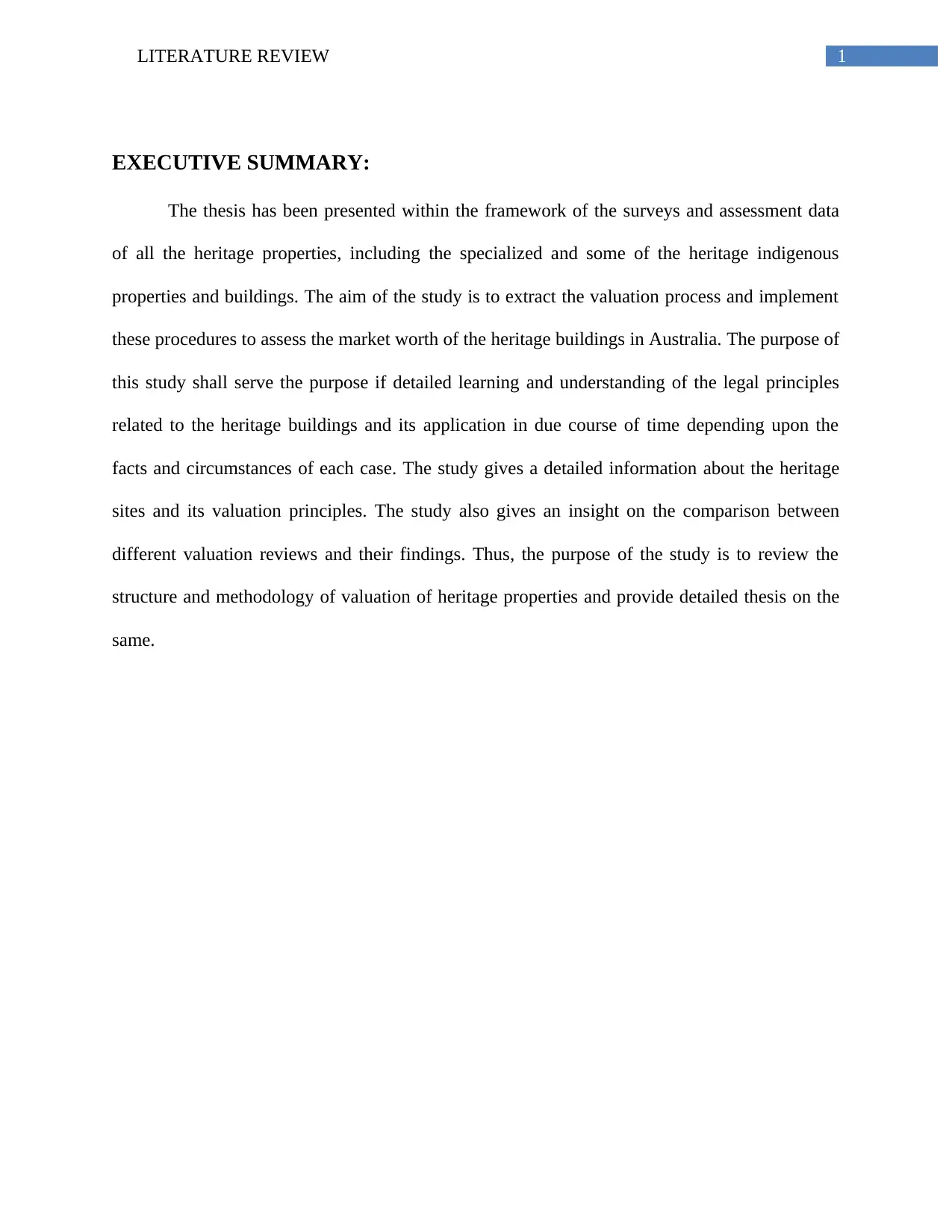
1LITERATURE REVIEW
EXECUTIVE SUMMARY:
The thesis has been presented within the framework of the surveys and assessment data
of all the heritage properties, including the specialized and some of the heritage indigenous
properties and buildings. The aim of the study is to extract the valuation process and implement
these procedures to assess the market worth of the heritage buildings in Australia. The purpose of
this study shall serve the purpose if detailed learning and understanding of the legal principles
related to the heritage buildings and its application in due course of time depending upon the
facts and circumstances of each case. The study gives a detailed information about the heritage
sites and its valuation principles. The study also gives an insight on the comparison between
different valuation reviews and their findings. Thus, the purpose of the study is to review the
structure and methodology of valuation of heritage properties and provide detailed thesis on the
same.
EXECUTIVE SUMMARY:
The thesis has been presented within the framework of the surveys and assessment data
of all the heritage properties, including the specialized and some of the heritage indigenous
properties and buildings. The aim of the study is to extract the valuation process and implement
these procedures to assess the market worth of the heritage buildings in Australia. The purpose of
this study shall serve the purpose if detailed learning and understanding of the legal principles
related to the heritage buildings and its application in due course of time depending upon the
facts and circumstances of each case. The study gives a detailed information about the heritage
sites and its valuation principles. The study also gives an insight on the comparison between
different valuation reviews and their findings. Thus, the purpose of the study is to review the
structure and methodology of valuation of heritage properties and provide detailed thesis on the
same.
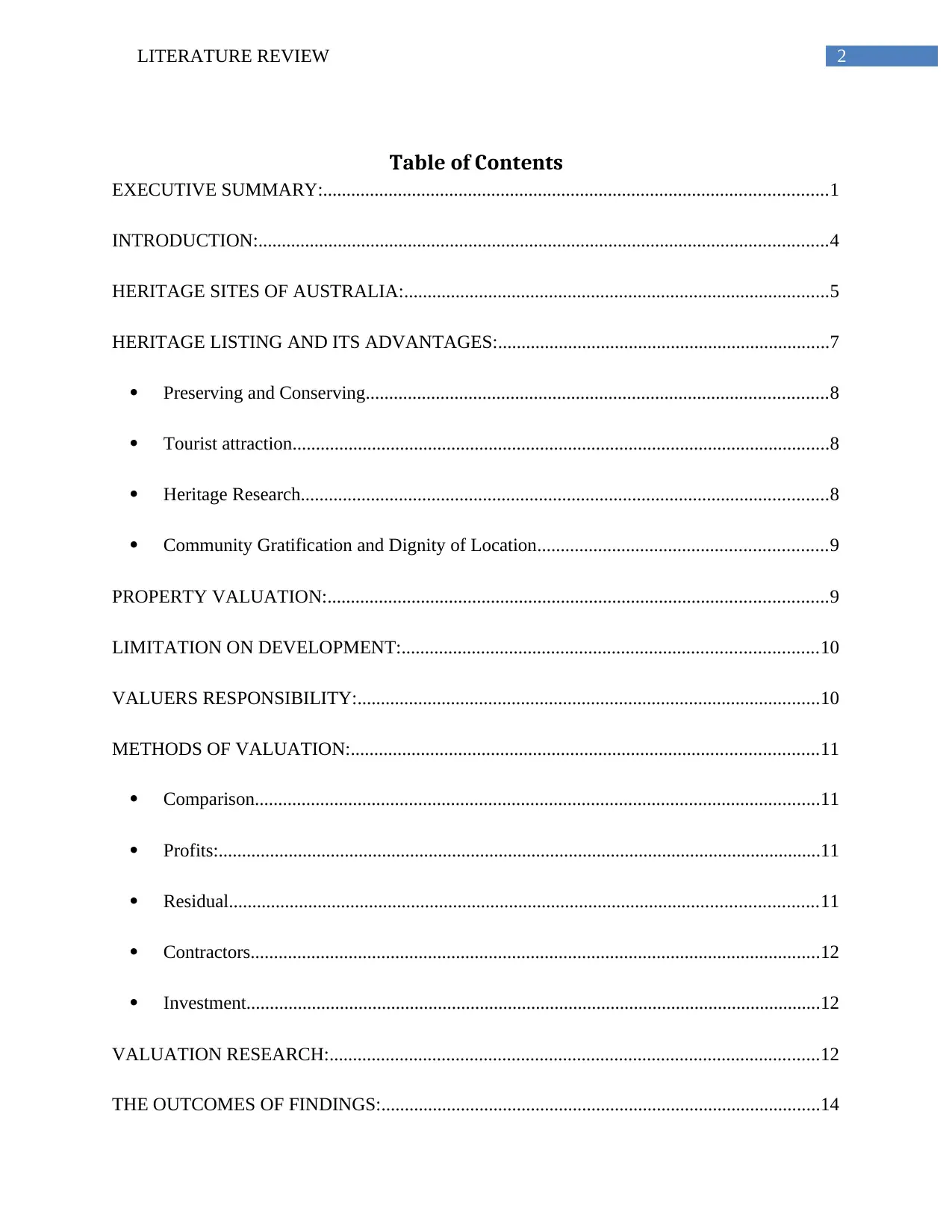
2LITERATURE REVIEW
Table of Contents
EXECUTIVE SUMMARY:............................................................................................................1
INTRODUCTION:..........................................................................................................................4
HERITAGE SITES OF AUSTRALIA:...........................................................................................5
HERITAGE LISTING AND ITS ADVANTAGES:.......................................................................7
Preserving and Conserving...................................................................................................8
Tourist attraction...................................................................................................................8
Heritage Research.................................................................................................................8
Community Gratification and Dignity of Location..............................................................9
PROPERTY VALUATION:...........................................................................................................9
LIMITATION ON DEVELOPMENT:.........................................................................................10
VALUERS RESPONSIBILITY:...................................................................................................10
METHODS OF VALUATION:....................................................................................................11
Comparison.........................................................................................................................11
Profits:.................................................................................................................................11
Residual..............................................................................................................................11
Contractors..........................................................................................................................12
Investment...........................................................................................................................12
VALUATION RESEARCH:.........................................................................................................12
THE OUTCOMES OF FINDINGS:..............................................................................................14
Table of Contents
EXECUTIVE SUMMARY:............................................................................................................1
INTRODUCTION:..........................................................................................................................4
HERITAGE SITES OF AUSTRALIA:...........................................................................................5
HERITAGE LISTING AND ITS ADVANTAGES:.......................................................................7
Preserving and Conserving...................................................................................................8
Tourist attraction...................................................................................................................8
Heritage Research.................................................................................................................8
Community Gratification and Dignity of Location..............................................................9
PROPERTY VALUATION:...........................................................................................................9
LIMITATION ON DEVELOPMENT:.........................................................................................10
VALUERS RESPONSIBILITY:...................................................................................................10
METHODS OF VALUATION:....................................................................................................11
Comparison.........................................................................................................................11
Profits:.................................................................................................................................11
Residual..............................................................................................................................11
Contractors..........................................................................................................................12
Investment...........................................................................................................................12
VALUATION RESEARCH:.........................................................................................................12
THE OUTCOMES OF FINDINGS:..............................................................................................14
⊘ This is a preview!⊘
Do you want full access?
Subscribe today to unlock all pages.

Trusted by 1+ million students worldwide

3LITERATURE REVIEW
CONSIDERATIONS WHILE EVALUATING HERITAGE PROPERTY:................................15
LIMITATIONS TO RESEARCH:................................................................................................15
CONCLUSION:............................................................................................................................16
REFERENCES:.............................................................................................................................17
CONSIDERATIONS WHILE EVALUATING HERITAGE PROPERTY:................................15
LIMITATIONS TO RESEARCH:................................................................................................15
CONCLUSION:............................................................................................................................16
REFERENCES:.............................................................................................................................17
Paraphrase This Document
Need a fresh take? Get an instant paraphrase of this document with our AI Paraphraser
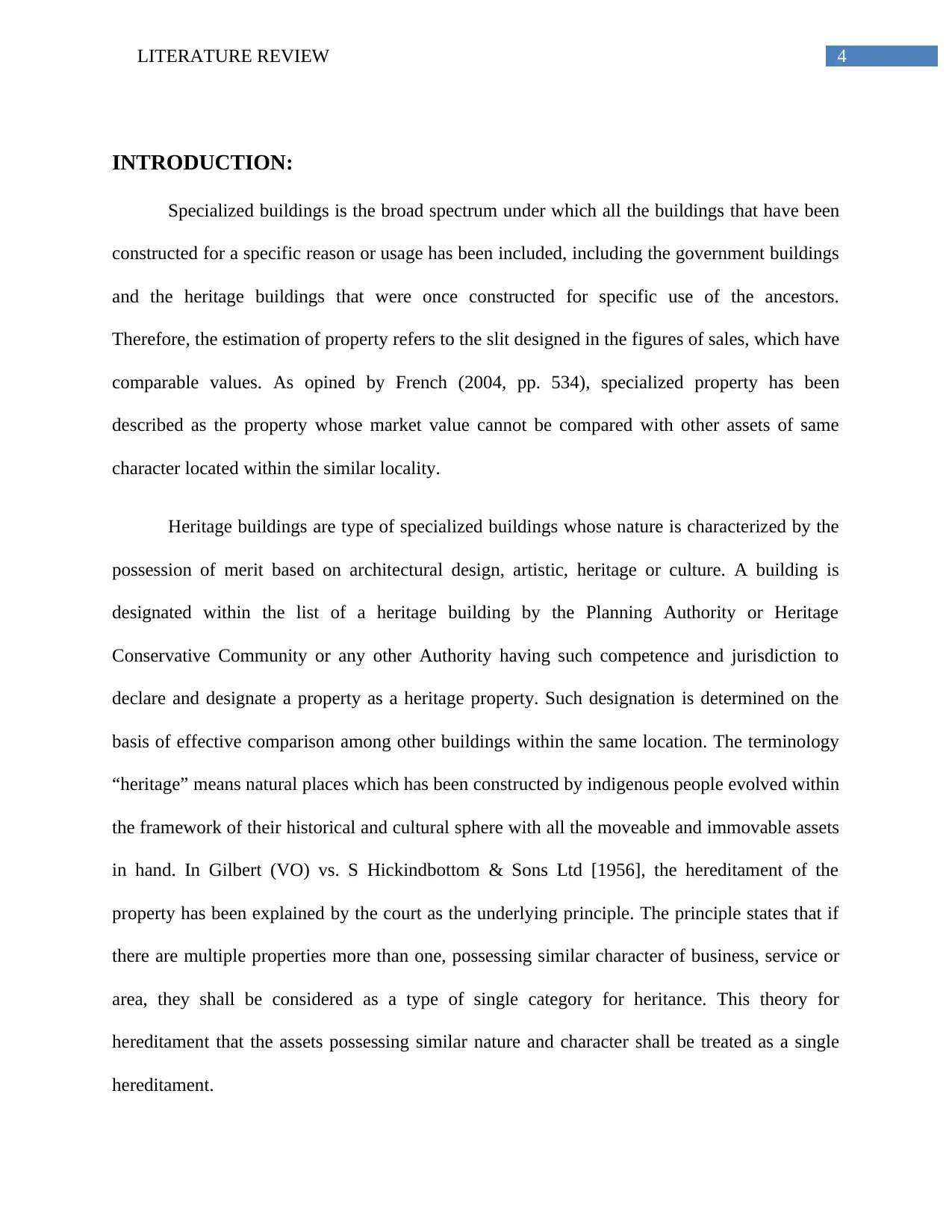
4LITERATURE REVIEW
INTRODUCTION:
Specialized buildings is the broad spectrum under which all the buildings that have been
constructed for a specific reason or usage has been included, including the government buildings
and the heritage buildings that were once constructed for specific use of the ancestors.
Therefore, the estimation of property refers to the slit designed in the figures of sales, which have
comparable values. As opined by French (2004, pp. 534), specialized property has been
described as the property whose market value cannot be compared with other assets of same
character located within the similar locality.
Heritage buildings are type of specialized buildings whose nature is characterized by the
possession of merit based on architectural design, artistic, heritage or culture. A building is
designated within the list of a heritage building by the Planning Authority or Heritage
Conservative Community or any other Authority having such competence and jurisdiction to
declare and designate a property as a heritage property. Such designation is determined on the
basis of effective comparison among other buildings within the same location. The terminology
“heritage” means natural places which has been constructed by indigenous people evolved within
the framework of their historical and cultural sphere with all the moveable and immovable assets
in hand. In Gilbert (VO) vs. S Hickindbottom & Sons Ltd [1956], the hereditament of the
property has been explained by the court as the underlying principle. The principle states that if
there are multiple properties more than one, possessing similar character of business, service or
area, they shall be considered as a type of single category for heritance. This theory for
hereditament that the assets possessing similar nature and character shall be treated as a single
hereditament.
INTRODUCTION:
Specialized buildings is the broad spectrum under which all the buildings that have been
constructed for a specific reason or usage has been included, including the government buildings
and the heritage buildings that were once constructed for specific use of the ancestors.
Therefore, the estimation of property refers to the slit designed in the figures of sales, which have
comparable values. As opined by French (2004, pp. 534), specialized property has been
described as the property whose market value cannot be compared with other assets of same
character located within the similar locality.
Heritage buildings are type of specialized buildings whose nature is characterized by the
possession of merit based on architectural design, artistic, heritage or culture. A building is
designated within the list of a heritage building by the Planning Authority or Heritage
Conservative Community or any other Authority having such competence and jurisdiction to
declare and designate a property as a heritage property. Such designation is determined on the
basis of effective comparison among other buildings within the same location. The terminology
“heritage” means natural places which has been constructed by indigenous people evolved within
the framework of their historical and cultural sphere with all the moveable and immovable assets
in hand. In Gilbert (VO) vs. S Hickindbottom & Sons Ltd [1956], the hereditament of the
property has been explained by the court as the underlying principle. The principle states that if
there are multiple properties more than one, possessing similar character of business, service or
area, they shall be considered as a type of single category for heritance. This theory for
hereditament that the assets possessing similar nature and character shall be treated as a single
hereditament.
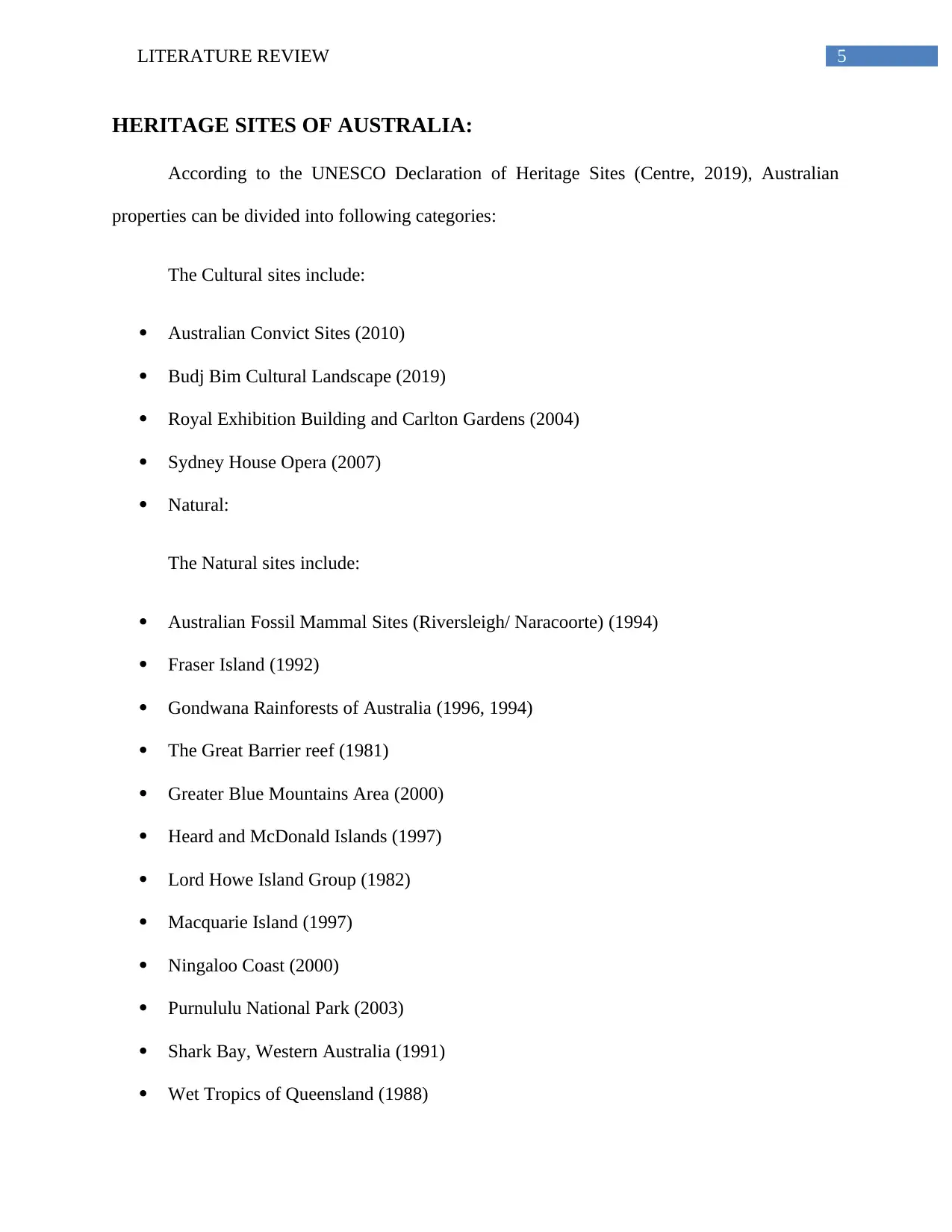
5LITERATURE REVIEW
HERITAGE SITES OF AUSTRALIA:
According to the UNESCO Declaration of Heritage Sites (Centre, 2019), Australian
properties can be divided into following categories:
The Cultural sites include:
Australian Convict Sites (2010)
Budj Bim Cultural Landscape (2019)
Royal Exhibition Building and Carlton Gardens (2004)
Sydney House Opera (2007)
Natural:
The Natural sites include:
Australian Fossil Mammal Sites (Riversleigh/ Naracoorte) (1994)
Fraser Island (1992)
Gondwana Rainforests of Australia (1996, 1994)
The Great Barrier reef (1981)
Greater Blue Mountains Area (2000)
Heard and McDonald Islands (1997)
Lord Howe Island Group (1982)
Macquarie Island (1997)
Ningaloo Coast (2000)
Purnululu National Park (2003)
Shark Bay, Western Australia (1991)
Wet Tropics of Queensland (1988)
HERITAGE SITES OF AUSTRALIA:
According to the UNESCO Declaration of Heritage Sites (Centre, 2019), Australian
properties can be divided into following categories:
The Cultural sites include:
Australian Convict Sites (2010)
Budj Bim Cultural Landscape (2019)
Royal Exhibition Building and Carlton Gardens (2004)
Sydney House Opera (2007)
Natural:
The Natural sites include:
Australian Fossil Mammal Sites (Riversleigh/ Naracoorte) (1994)
Fraser Island (1992)
Gondwana Rainforests of Australia (1996, 1994)
The Great Barrier reef (1981)
Greater Blue Mountains Area (2000)
Heard and McDonald Islands (1997)
Lord Howe Island Group (1982)
Macquarie Island (1997)
Ningaloo Coast (2000)
Purnululu National Park (2003)
Shark Bay, Western Australia (1991)
Wet Tropics of Queensland (1988)
⊘ This is a preview!⊘
Do you want full access?
Subscribe today to unlock all pages.

Trusted by 1+ million students worldwide
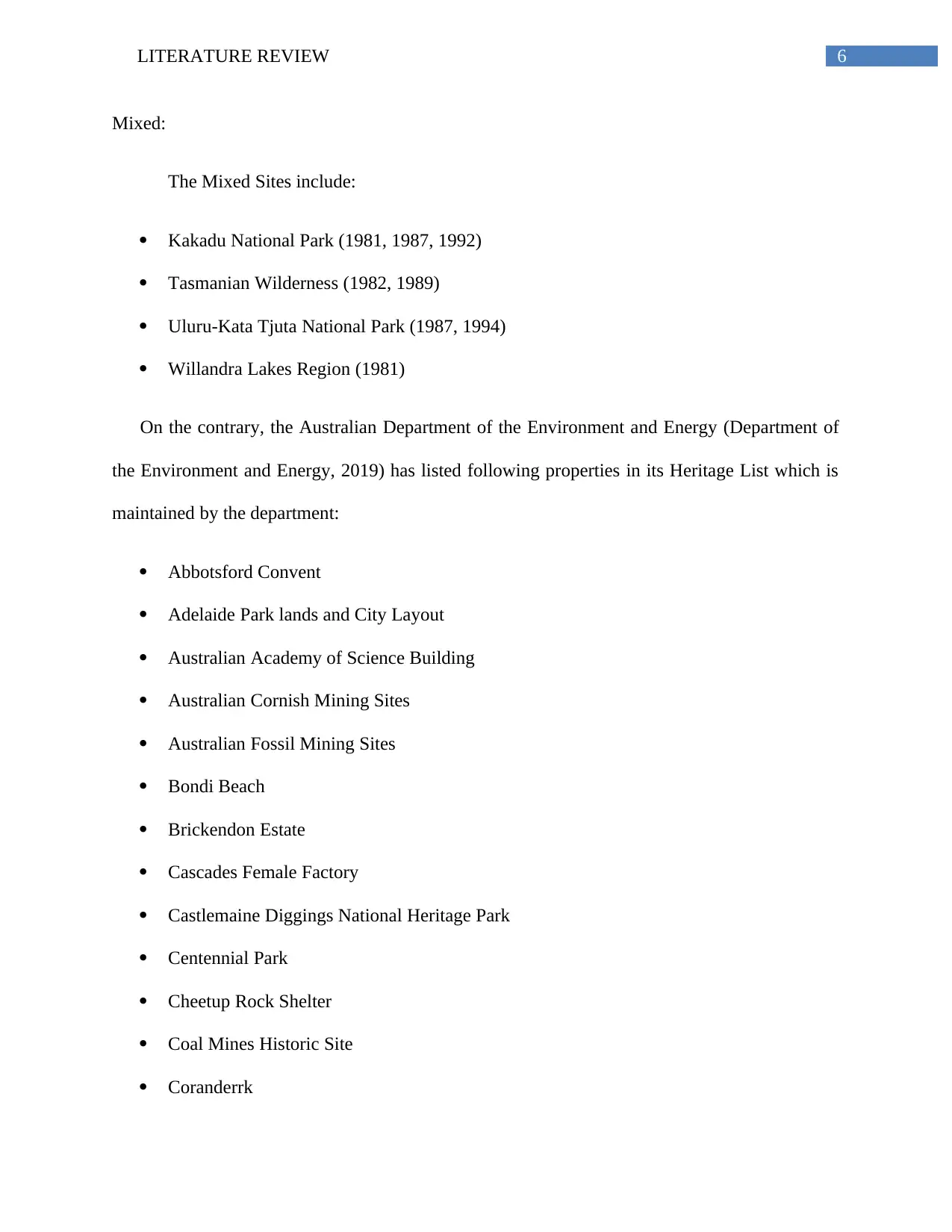
6LITERATURE REVIEW
Mixed:
The Mixed Sites include:
Kakadu National Park (1981, 1987, 1992)
Tasmanian Wilderness (1982, 1989)
Uluru-Kata Tjuta National Park (1987, 1994)
Willandra Lakes Region (1981)
On the contrary, the Australian Department of the Environment and Energy (Department of
the Environment and Energy, 2019) has listed following properties in its Heritage List which is
maintained by the department:
Abbotsford Convent
Adelaide Park lands and City Layout
Australian Academy of Science Building
Australian Cornish Mining Sites
Australian Fossil Mining Sites
Bondi Beach
Brickendon Estate
Cascades Female Factory
Castlemaine Diggings National Heritage Park
Centennial Park
Cheetup Rock Shelter
Coal Mines Historic Site
Coranderrk
Mixed:
The Mixed Sites include:
Kakadu National Park (1981, 1987, 1992)
Tasmanian Wilderness (1982, 1989)
Uluru-Kata Tjuta National Park (1987, 1994)
Willandra Lakes Region (1981)
On the contrary, the Australian Department of the Environment and Energy (Department of
the Environment and Energy, 2019) has listed following properties in its Heritage List which is
maintained by the department:
Abbotsford Convent
Adelaide Park lands and City Layout
Australian Academy of Science Building
Australian Cornish Mining Sites
Australian Fossil Mining Sites
Bondi Beach
Brickendon Estate
Cascades Female Factory
Castlemaine Diggings National Heritage Park
Centennial Park
Cheetup Rock Shelter
Coal Mines Historic Site
Coranderrk
Paraphrase This Document
Need a fresh take? Get an instant paraphrase of this document with our AI Paraphraser
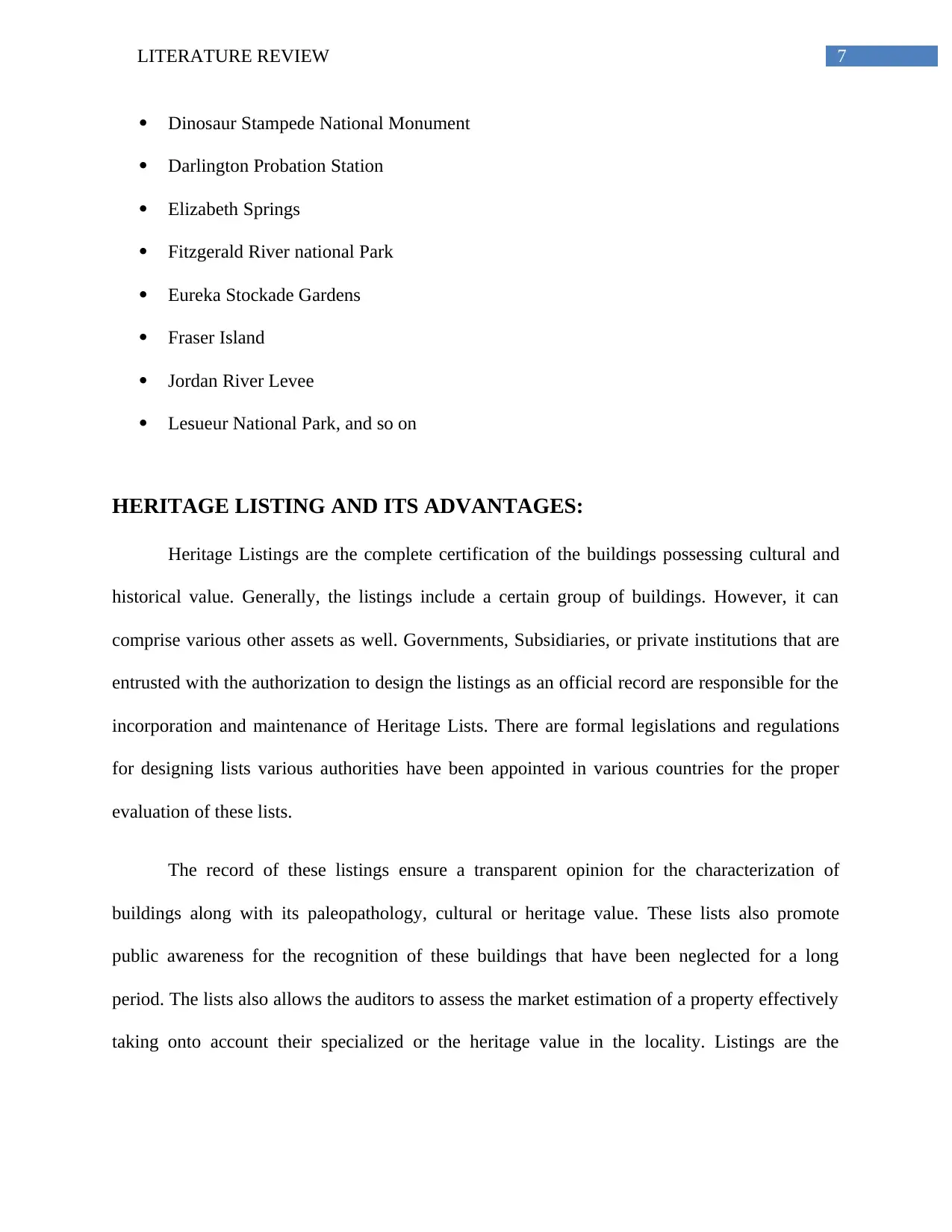
7LITERATURE REVIEW
Dinosaur Stampede National Monument
Darlington Probation Station
Elizabeth Springs
Fitzgerald River national Park
Eureka Stockade Gardens
Fraser Island
Jordan River Levee
Lesueur National Park, and so on
HERITAGE LISTING AND ITS ADVANTAGES:
Heritage Listings are the complete certification of the buildings possessing cultural and
historical value. Generally, the listings include a certain group of buildings. However, it can
comprise various other assets as well. Governments, Subsidiaries, or private institutions that are
entrusted with the authorization to design the listings as an official record are responsible for the
incorporation and maintenance of Heritage Lists. There are formal legislations and regulations
for designing lists various authorities have been appointed in various countries for the proper
evaluation of these lists.
The record of these listings ensure a transparent opinion for the characterization of
buildings along with its paleopathology, cultural or heritage value. These lists also promote
public awareness for the recognition of these buildings that have been neglected for a long
period. The lists also allows the auditors to assess the market estimation of a property effectively
taking onto account their specialized or the heritage value in the locality. Listings are the
Dinosaur Stampede National Monument
Darlington Probation Station
Elizabeth Springs
Fitzgerald River national Park
Eureka Stockade Gardens
Fraser Island
Jordan River Levee
Lesueur National Park, and so on
HERITAGE LISTING AND ITS ADVANTAGES:
Heritage Listings are the complete certification of the buildings possessing cultural and
historical value. Generally, the listings include a certain group of buildings. However, it can
comprise various other assets as well. Governments, Subsidiaries, or private institutions that are
entrusted with the authorization to design the listings as an official record are responsible for the
incorporation and maintenance of Heritage Lists. There are formal legislations and regulations
for designing lists various authorities have been appointed in various countries for the proper
evaluation of these lists.
The record of these listings ensure a transparent opinion for the characterization of
buildings along with its paleopathology, cultural or heritage value. These lists also promote
public awareness for the recognition of these buildings that have been neglected for a long
period. The lists also allows the auditors to assess the market estimation of a property effectively
taking onto account their specialized or the heritage value in the locality. Listings are the
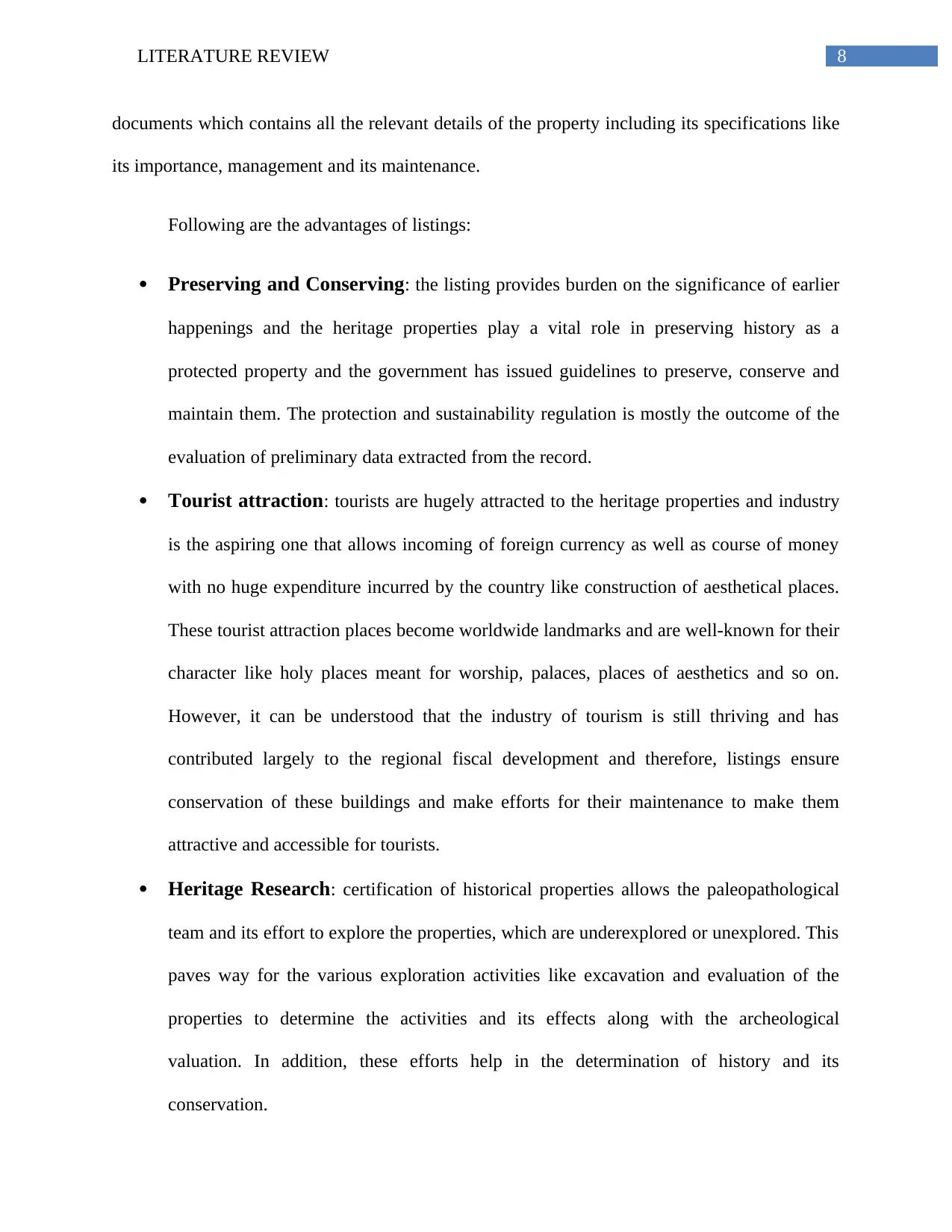
8LITERATURE REVIEW
documents which contains all the relevant details of the property including its specifications like
its importance, management and its maintenance.
Following are the advantages of listings:
Preserving and Conserving: the listing provides burden on the significance of earlier
happenings and the heritage properties play a vital role in preserving history as a
protected property and the government has issued guidelines to preserve, conserve and
maintain them. The protection and sustainability regulation is mostly the outcome of the
evaluation of preliminary data extracted from the record.
Tourist attraction: tourists are hugely attracted to the heritage properties and industry
is the aspiring one that allows incoming of foreign currency as well as course of money
with no huge expenditure incurred by the country like construction of aesthetical places.
These tourist attraction places become worldwide landmarks and are well-known for their
character like holy places meant for worship, palaces, places of aesthetics and so on.
However, it can be understood that the industry of tourism is still thriving and has
contributed largely to the regional fiscal development and therefore, listings ensure
conservation of these buildings and make efforts for their maintenance to make them
attractive and accessible for tourists.
Heritage Research: certification of historical properties allows the paleopathological
team and its effort to explore the properties, which are underexplored or unexplored. This
paves way for the various exploration activities like excavation and evaluation of the
properties to determine the activities and its effects along with the archeological
valuation. In addition, these efforts help in the determination of history and its
conservation.
documents which contains all the relevant details of the property including its specifications like
its importance, management and its maintenance.
Following are the advantages of listings:
Preserving and Conserving: the listing provides burden on the significance of earlier
happenings and the heritage properties play a vital role in preserving history as a
protected property and the government has issued guidelines to preserve, conserve and
maintain them. The protection and sustainability regulation is mostly the outcome of the
evaluation of preliminary data extracted from the record.
Tourist attraction: tourists are hugely attracted to the heritage properties and industry
is the aspiring one that allows incoming of foreign currency as well as course of money
with no huge expenditure incurred by the country like construction of aesthetical places.
These tourist attraction places become worldwide landmarks and are well-known for their
character like holy places meant for worship, palaces, places of aesthetics and so on.
However, it can be understood that the industry of tourism is still thriving and has
contributed largely to the regional fiscal development and therefore, listings ensure
conservation of these buildings and make efforts for their maintenance to make them
attractive and accessible for tourists.
Heritage Research: certification of historical properties allows the paleopathological
team and its effort to explore the properties, which are underexplored or unexplored. This
paves way for the various exploration activities like excavation and evaluation of the
properties to determine the activities and its effects along with the archeological
valuation. In addition, these efforts help in the determination of history and its
conservation.
⊘ This is a preview!⊘
Do you want full access?
Subscribe today to unlock all pages.

Trusted by 1+ million students worldwide
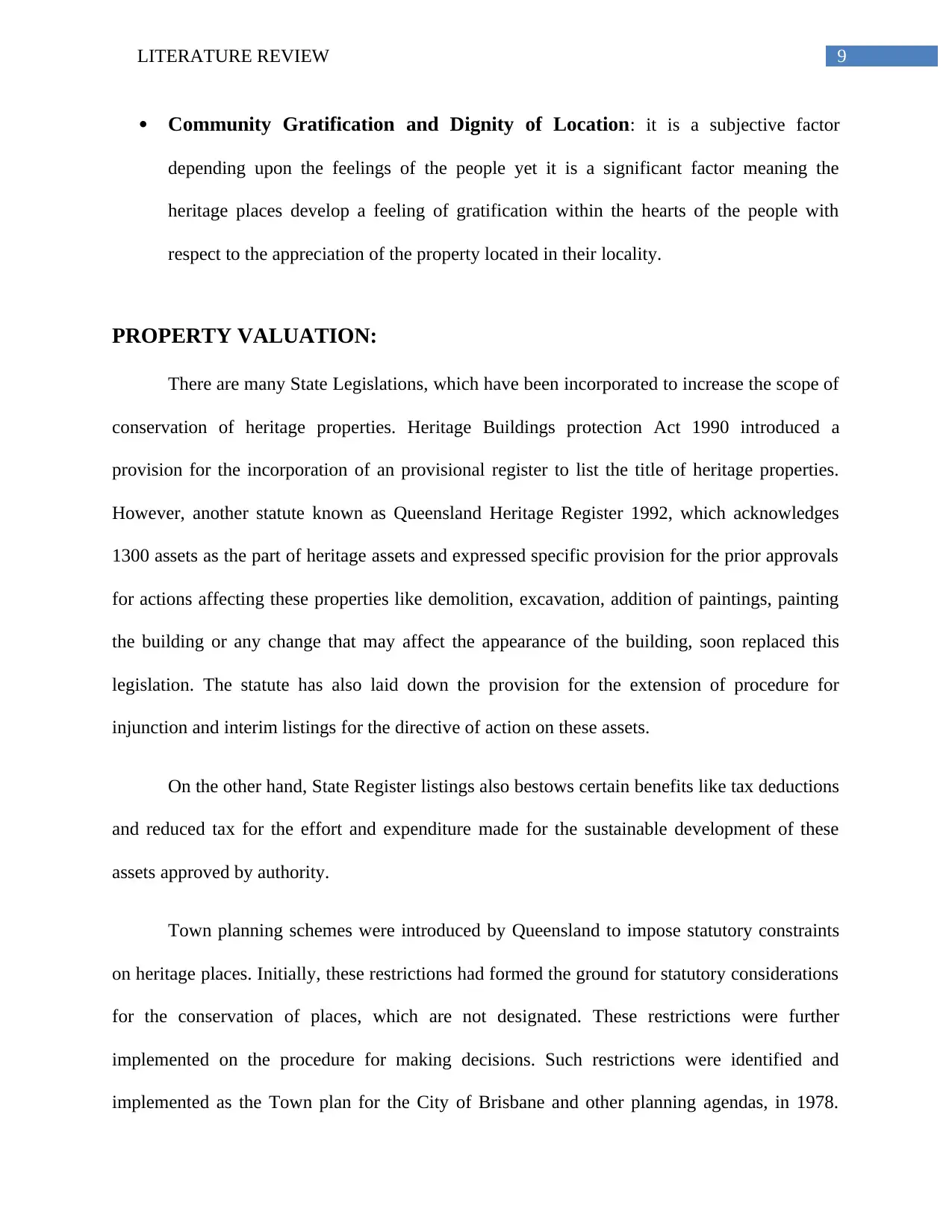
9LITERATURE REVIEW
Community Gratification and Dignity of Location: it is a subjective factor
depending upon the feelings of the people yet it is a significant factor meaning the
heritage places develop a feeling of gratification within the hearts of the people with
respect to the appreciation of the property located in their locality.
PROPERTY VALUATION:
There are many State Legislations, which have been incorporated to increase the scope of
conservation of heritage properties. Heritage Buildings protection Act 1990 introduced a
provision for the incorporation of an provisional register to list the title of heritage properties.
However, another statute known as Queensland Heritage Register 1992, which acknowledges
1300 assets as the part of heritage assets and expressed specific provision for the prior approvals
for actions affecting these properties like demolition, excavation, addition of paintings, painting
the building or any change that may affect the appearance of the building, soon replaced this
legislation. The statute has also laid down the provision for the extension of procedure for
injunction and interim listings for the directive of action on these assets.
On the other hand, State Register listings also bestows certain benefits like tax deductions
and reduced tax for the effort and expenditure made for the sustainable development of these
assets approved by authority.
Town planning schemes were introduced by Queensland to impose statutory constraints
on heritage places. Initially, these restrictions had formed the ground for statutory considerations
for the conservation of places, which are not designated. These restrictions were further
implemented on the procedure for making decisions. Such restrictions were identified and
implemented as the Town plan for the City of Brisbane and other planning agendas, in 1978.
Community Gratification and Dignity of Location: it is a subjective factor
depending upon the feelings of the people yet it is a significant factor meaning the
heritage places develop a feeling of gratification within the hearts of the people with
respect to the appreciation of the property located in their locality.
PROPERTY VALUATION:
There are many State Legislations, which have been incorporated to increase the scope of
conservation of heritage properties. Heritage Buildings protection Act 1990 introduced a
provision for the incorporation of an provisional register to list the title of heritage properties.
However, another statute known as Queensland Heritage Register 1992, which acknowledges
1300 assets as the part of heritage assets and expressed specific provision for the prior approvals
for actions affecting these properties like demolition, excavation, addition of paintings, painting
the building or any change that may affect the appearance of the building, soon replaced this
legislation. The statute has also laid down the provision for the extension of procedure for
injunction and interim listings for the directive of action on these assets.
On the other hand, State Register listings also bestows certain benefits like tax deductions
and reduced tax for the effort and expenditure made for the sustainable development of these
assets approved by authority.
Town planning schemes were introduced by Queensland to impose statutory constraints
on heritage places. Initially, these restrictions had formed the ground for statutory considerations
for the conservation of places, which are not designated. These restrictions were further
implemented on the procedure for making decisions. Such restrictions were identified and
implemented as the Town plan for the City of Brisbane and other planning agendas, in 1978.
Paraphrase This Document
Need a fresh take? Get an instant paraphrase of this document with our AI Paraphraser
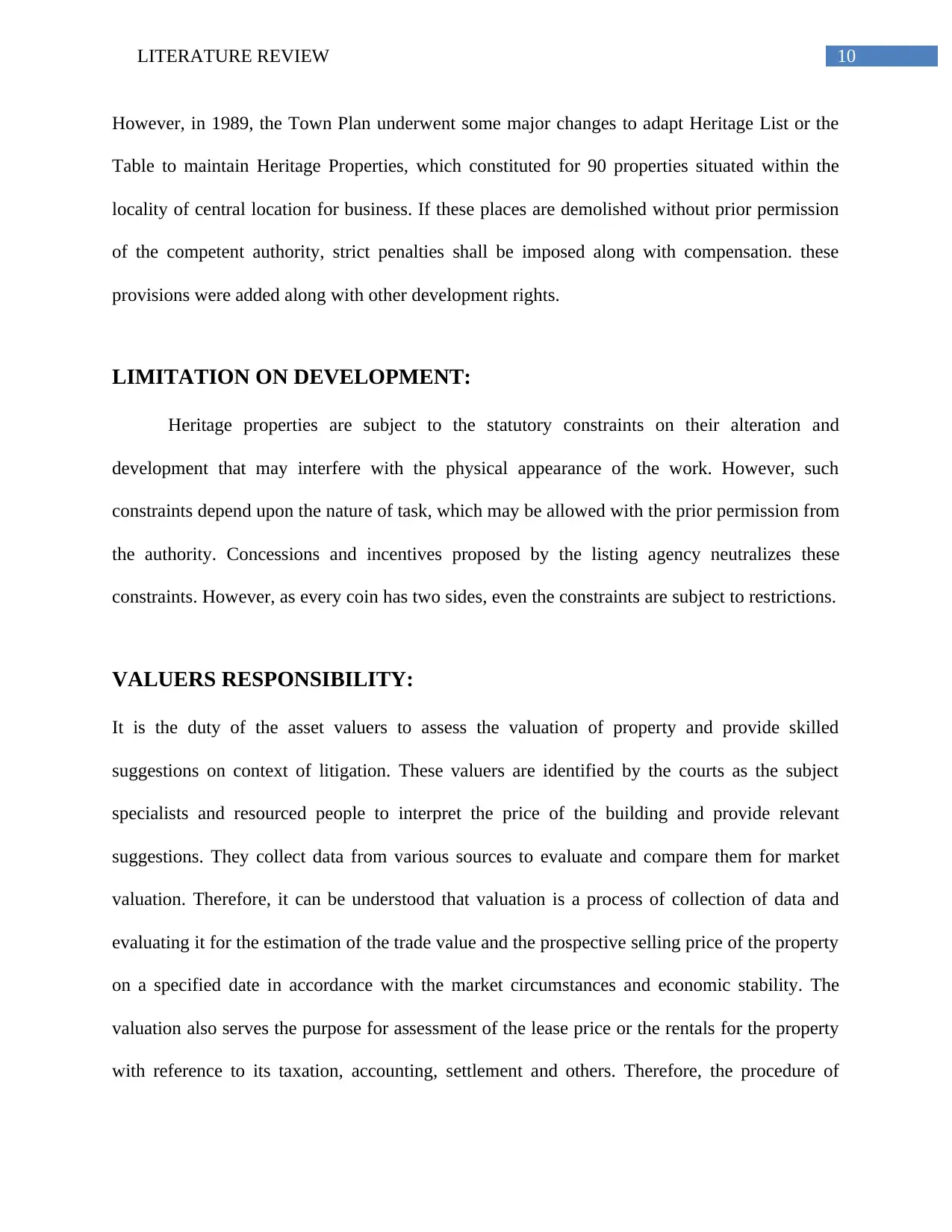
10LITERATURE REVIEW
However, in 1989, the Town Plan underwent some major changes to adapt Heritage List or the
Table to maintain Heritage Properties, which constituted for 90 properties situated within the
locality of central location for business. If these places are demolished without prior permission
of the competent authority, strict penalties shall be imposed along with compensation. these
provisions were added along with other development rights.
LIMITATION ON DEVELOPMENT:
Heritage properties are subject to the statutory constraints on their alteration and
development that may interfere with the physical appearance of the work. However, such
constraints depend upon the nature of task, which may be allowed with the prior permission from
the authority. Concessions and incentives proposed by the listing agency neutralizes these
constraints. However, as every coin has two sides, even the constraints are subject to restrictions.
VALUERS RESPONSIBILITY:
It is the duty of the asset valuers to assess the valuation of property and provide skilled
suggestions on context of litigation. These valuers are identified by the courts as the subject
specialists and resourced people to interpret the price of the building and provide relevant
suggestions. They collect data from various sources to evaluate and compare them for market
valuation. Therefore, it can be understood that valuation is a process of collection of data and
evaluating it for the estimation of the trade value and the prospective selling price of the property
on a specified date in accordance with the market circumstances and economic stability. The
valuation also serves the purpose for assessment of the lease price or the rentals for the property
with reference to its taxation, accounting, settlement and others. Therefore, the procedure of
However, in 1989, the Town Plan underwent some major changes to adapt Heritage List or the
Table to maintain Heritage Properties, which constituted for 90 properties situated within the
locality of central location for business. If these places are demolished without prior permission
of the competent authority, strict penalties shall be imposed along with compensation. these
provisions were added along with other development rights.
LIMITATION ON DEVELOPMENT:
Heritage properties are subject to the statutory constraints on their alteration and
development that may interfere with the physical appearance of the work. However, such
constraints depend upon the nature of task, which may be allowed with the prior permission from
the authority. Concessions and incentives proposed by the listing agency neutralizes these
constraints. However, as every coin has two sides, even the constraints are subject to restrictions.
VALUERS RESPONSIBILITY:
It is the duty of the asset valuers to assess the valuation of property and provide skilled
suggestions on context of litigation. These valuers are identified by the courts as the subject
specialists and resourced people to interpret the price of the building and provide relevant
suggestions. They collect data from various sources to evaluate and compare them for market
valuation. Therefore, it can be understood that valuation is a process of collection of data and
evaluating it for the estimation of the trade value and the prospective selling price of the property
on a specified date in accordance with the market circumstances and economic stability. The
valuation also serves the purpose for assessment of the lease price or the rentals for the property
with reference to its taxation, accounting, settlement and others. Therefore, the procedure of
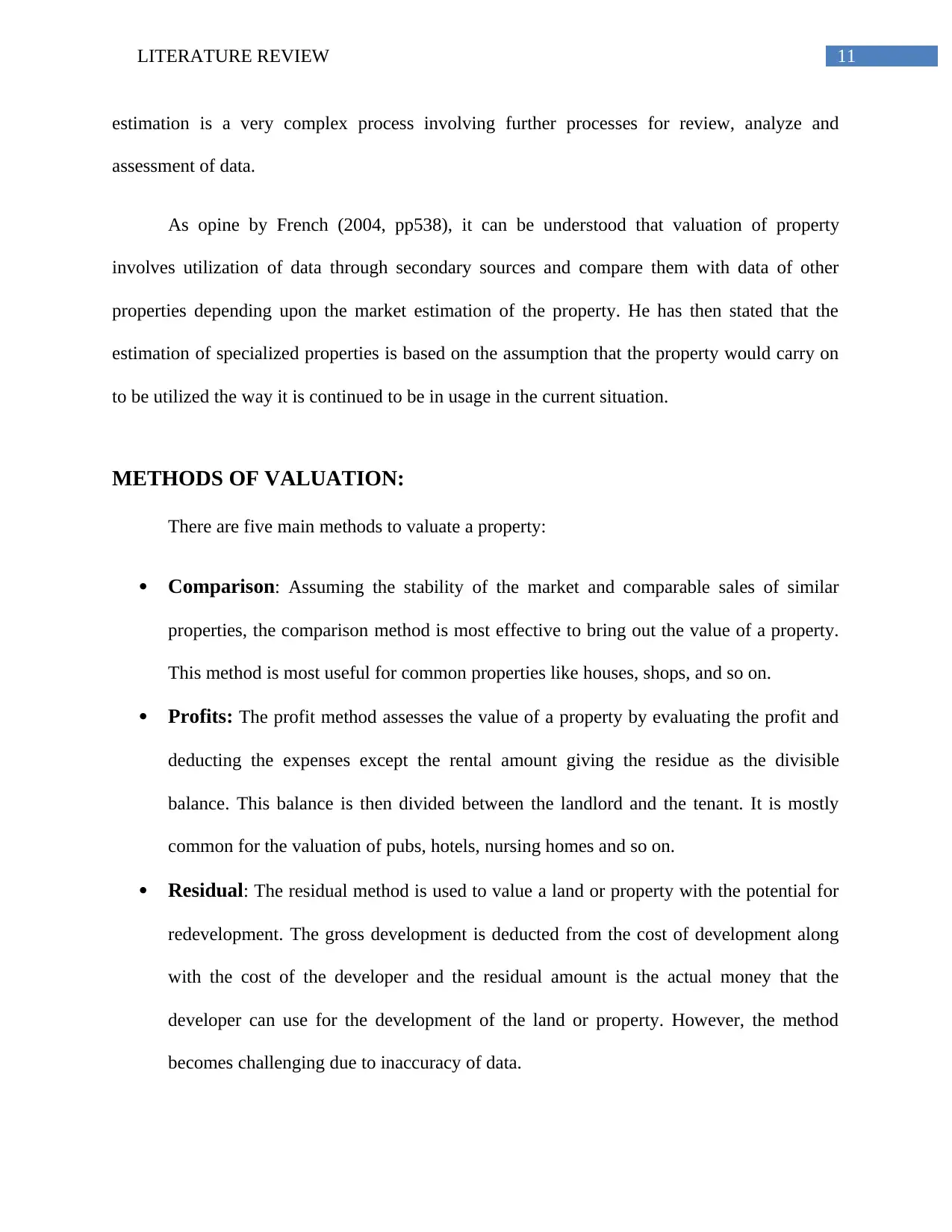
11LITERATURE REVIEW
estimation is a very complex process involving further processes for review, analyze and
assessment of data.
As opine by French (2004, pp538), it can be understood that valuation of property
involves utilization of data through secondary sources and compare them with data of other
properties depending upon the market estimation of the property. He has then stated that the
estimation of specialized properties is based on the assumption that the property would carry on
to be utilized the way it is continued to be in usage in the current situation.
METHODS OF VALUATION:
There are five main methods to valuate a property:
Comparison: Assuming the stability of the market and comparable sales of similar
properties, the comparison method is most effective to bring out the value of a property.
This method is most useful for common properties like houses, shops, and so on.
Profits: The profit method assesses the value of a property by evaluating the profit and
deducting the expenses except the rental amount giving the residue as the divisible
balance. This balance is then divided between the landlord and the tenant. It is mostly
common for the valuation of pubs, hotels, nursing homes and so on.
Residual: The residual method is used to value a land or property with the potential for
redevelopment. The gross development is deducted from the cost of development along
with the cost of the developer and the residual amount is the actual money that the
developer can use for the development of the land or property. However, the method
becomes challenging due to inaccuracy of data.
estimation is a very complex process involving further processes for review, analyze and
assessment of data.
As opine by French (2004, pp538), it can be understood that valuation of property
involves utilization of data through secondary sources and compare them with data of other
properties depending upon the market estimation of the property. He has then stated that the
estimation of specialized properties is based on the assumption that the property would carry on
to be utilized the way it is continued to be in usage in the current situation.
METHODS OF VALUATION:
There are five main methods to valuate a property:
Comparison: Assuming the stability of the market and comparable sales of similar
properties, the comparison method is most effective to bring out the value of a property.
This method is most useful for common properties like houses, shops, and so on.
Profits: The profit method assesses the value of a property by evaluating the profit and
deducting the expenses except the rental amount giving the residue as the divisible
balance. This balance is then divided between the landlord and the tenant. It is mostly
common for the valuation of pubs, hotels, nursing homes and so on.
Residual: The residual method is used to value a land or property with the potential for
redevelopment. The gross development is deducted from the cost of development along
with the cost of the developer and the residual amount is the actual money that the
developer can use for the development of the land or property. However, the method
becomes challenging due to inaccuracy of data.
⊘ This is a preview!⊘
Do you want full access?
Subscribe today to unlock all pages.

Trusted by 1+ million students worldwide
1 out of 20
Related Documents
Your All-in-One AI-Powered Toolkit for Academic Success.
+13062052269
info@desklib.com
Available 24*7 on WhatsApp / Email
![[object Object]](/_next/static/media/star-bottom.7253800d.svg)
Unlock your academic potential
Copyright © 2020–2025 A2Z Services. All Rights Reserved. Developed and managed by ZUCOL.





